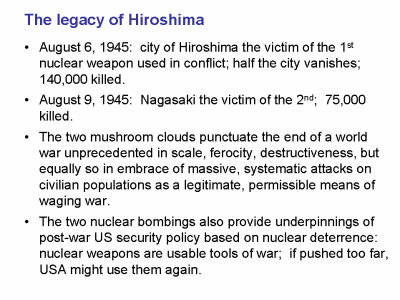| front |1 |2 |3 |4 |5 |6 |7 |8 |9 |10 |11 |12 |13 |14 |15 |16 |17 |18 |19 |20 |21 |22 |23 |24 |25 |26 |27 |28 |29 |30 |31 |32 |33 |34 |35 |36 |37 |38 |39 |40 |41 |42 |43 |44 |45 |46 |47 |48 |review |
 |
...thereby punctuating,
with mushroom-shaped exclamation points, the end of a world conflict
notable not only for its immense scale and destruc負iveness but also
for the extent to which the major com苑atants had come to regard
massive attacks on civilian populations as a permissible means of
waging war.
The nuclear attacks on
Hiroshima and Nagasaki, although they were hardly the first
instances of wholesale devastation of cities in World War 2, did
demonstrate a terrible new level of technological ef苯icien苞y in
the implemen負ation of the "strategic bombing" approach to warfare
which that conflict had spawned.
The two nuclear bombings also provided the underpin要ings of
a post-war U.S. security policy based on nuclear deterrence -- that
is, on the idea that the United States might well be willing to use
against others the same awesome capacity for nuclear destruc負ion
that it had used against Japan in August of 1945.
|